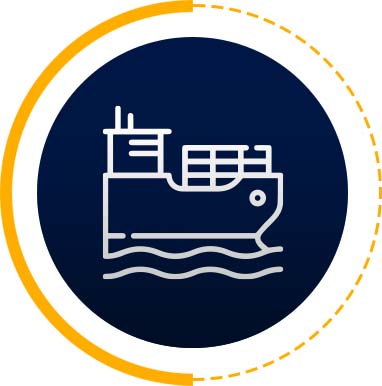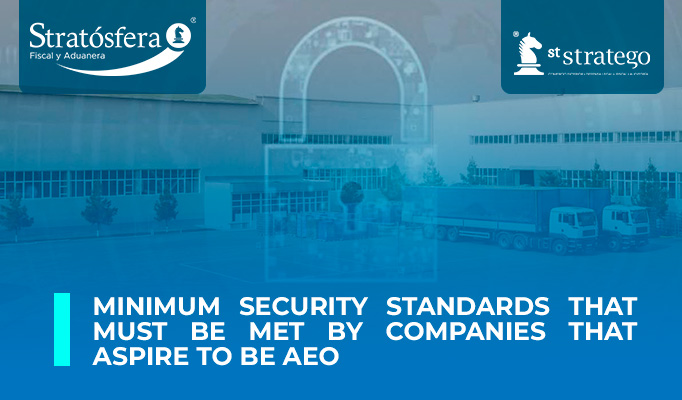 The Authorized Economic Operator (AEO) certification is a program that seeks to strengthen the security of the logistics chain of foreign trade through the implementation of minimum requirements in terms of internationally recognized security, and in coordination with the private sector, which gives very interesting benefits to the participating companies.
The Authorized Economic Operator (AEO) certification is a program that seeks to strengthen the security of the logistics chain of foreign trade through the implementation of minimum requirements in terms of internationally recognized security, and in coordination with the private sector, which gives very interesting benefits to the participating companies.
Companies interested in obtaining their registration to the Registry in the Business Certification Scheme in the Economic or Authorized Operator modality must demonstrate that they have documented and verifiable processes required according to the business model or design that are based on risk management, seeking during the implementation of the minimum standards in terms of security ridded, the application of a culture of analysis that supports preventive and reactive decision-making in the face of threats and / or risk circumstances according to the values, mission, vision, codes of ethics and conduct of the company itself.
The AEO program is based mainly on the security of the supply chain and consists of 11 standards, so below is a precise description of the minimum points that must be contemplated of each element.
- Security Planning in the Supply Chain.
Companies must develop documented policies and procedures to carry out an analysis that allows the identification of risks and weaknesses in their supply chain, implement and strategies that help mitigate risk in their company. In this sense, companies must develop risk analysis, internal audits, emergency and/or contingency plans and a security policy aimed at preventing, ensuring and recognizing threats to the security of the supply chain.
- Physical security.
The company must have in place mechanisms and documented processes to prevent, detect or deter the entry of unauthorized personnel into the facilities. All sensitive areas of the company must have physical barriers, control elements and deterrence against unauthorized access; you must have instruments such as a closed-circuit television and video surveillance system, perimeter fences, access controls, between or between.
- Physical access controls.
Identification processes for all employees, visitors and suppliers should be implemented at all points of entry. Likewise, records must be kept and the mechanisms or documented procedures of entry to the facilities must be permanently evaluated.
- Business partners.
The company must have written and verifiable procedures for the selection and hiring of business partners (carriers, for the transfer and / or distribution of goods from foreign trade, customs agents, warehouses, sub-maquila companies, manufacturers, sellers, suppliers of parts and raw materials, suppliers of cleaning services, private security, hiring of personnel, among others).
- Process safety.
Control measures must be established to guarantee the integrity and safety of the merchandise of the processes related to the transport, handling, customs clearance, storage and / or distribution of cargo along the supply chain.
- Customs management.
The company must have documented procedures in which internal and operational policies are established, as well as the necessary controls for the proper fulfillment of customs obligations.
- Safety of cargo vehicles and containers.
Safety must be maintained in the means of transport to protect them from the introduction of unauthorized persons and/or materials. It is necessary to have procedures in place to properly seal and maintain the integrity of containers and trailers from the point of origin, by means of high security seals to all containers and trailers to foreign trade shipments, which must comply with or exceed the ISO 17712 standard for high security seal sad. In addition, all means of transport must be inspected at the entrance and exit of the stations.
- Staff safety.
Documented procedures should be in place for the registration and evaluation of individuals who wish to obtain employment in the company and methods for conducting periodic checks of current employees should be established.
- Information security and documentation.
There must be preventive measures to maintain the confidentiality and integrity of the information and documentation generated by the company’s systems, including those used for the exchange of information with other members of the supply chain.
- Safety and awareness training.
There should be a documented threat awareness program, which should be established and maintained by security personnel to recognize and raise awareness of threats from terrorists and smugglers at every point in the supply chain. Employees should know the procedures in place in the company to consider a situation and know how to report it.
- Incident management and investigation.
There should be documented procedures for reporting and investigating security incidents in the supply chain, the actions to be taken to prevent their recurrence, and for notifying security personnel and/or other competent authorities. The investigation and analysis of incidents must be documented (physical and/or electronic file).
As you can see, the key point of the certification is the establishment of security standards, their correct implementation and their maintenance. With the above, minimum criteria are established to provide certainty to the authorities and business partners that their cargo will be at all times well monitored and protected against any type of alteration or contamination.
This document does not constitute a particular consultation, and therefore, Asesores Stratego SC, is not responsible for the interpretation or application given to it. The total or partial reproduction of this publication, by any means or procedure, is prohibited without the prior, express and written authorization of the author. Any form of unauthorized use will be prosecuted in accordance with the provisions of the Federal Copyright Law. We are at your service to answer your questions or comments, for more information on this subject and our services, please contact us at: info@asesores-stratego.com
or application given to it. The total or partial reproduction of this publication, by any means or procedure, is prohibited without the prior, express and written authorization of the author. Any form of unauthorized use will be prosecuted in accordance with the provisions of the Federal Copyright Law. We are at your service to answer your questions or comments, for more information on this subject and our services, please contact us at: info@asesores-stratego.com




